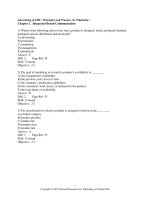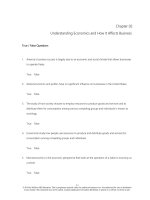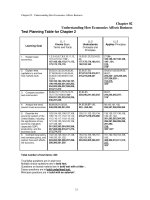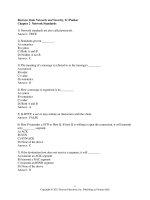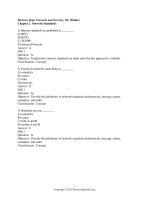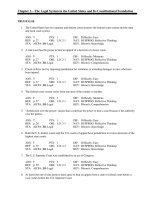Cengage advantage books business law principles and practices 9th edition goldman test bank
Bạn đang xem bản rút gọn của tài liệu. Xem và tải ngay bản đầy đủ của tài liệu tại đây (126.19 KB, 9 trang )
Chapter 2—The Legal System in the United States and Its Constitutional Foundation
TRUE/FALSE
1. The United States has two separate and distinct court systems: the federal court system and the state
and local court system.
ANS: T
PTS: 1
REF: p. 27
OBJ: LO: 2-1
STA: AICPA: BB-Legal
DIF: Difficulty: Easy
NAT: BUSPROG: Reflective Thinking
KEY: Bloom's: Knowledge
2. A trial court has the power to hear an appeal of a decision of a lower court.
ANS: F
PTS: 1
REF: p. 27
OBJ: LO: 2-1
STA: AICPA: BB-Legal
DIF: Difficulty: Moderate
NAT: BUSPROG: Reflective Thinking
KEY: Bloom's: Comprehension
3. Courts enforce law by imposing punishment for violations or awarding damages to ones who have
been injured.
ANS: T
PTS: 1
REF: p. 27
OBJ: LO: 2-1
STA: AICPA: BB-Legal
DIF: Difficulty: Easy
NAT: BUSPROG: Reflective Thinking
KEY: Bloom's: Knowledge
4. The federal court system varies from one area of the country to another.
ANS: F
PTS: 1
REF: p. 27
OBJ: LO: 2-1
STA: AICPA: BB-Legal
DIF: Difficulty: Moderate
NAT: BUSPROG: Reflective Thinking
KEY: Bloom's: Comprehension
5. "Jurisdiction over the person" means that a court has the power to hear a case because it has authority
over the parties.
ANS: T
PTS: 1
REF: p. 28
OBJ: LO: 2-1
STA: AICPA: BB-Legal
DIF: Difficulty: Easy
NAT: BUSPROG: Reflective Thinking
KEY: Bloom's: Knowledge
6. Both the U.S. district courts and the U.S. courts of appeal have jurisdiction to review decisions of the
highest state courts.
ANS: F
PTS: 1
REF: p. 39
OBJ: LO: 2-3
STA: AICPA: BB-Legal
DIF: Difficulty: Easy
NAT: BUSPROG: Reflective Thinking
KEY: Bloom's: Knowledge
7. The U.S. Supreme Court was established by an act of Congress.
ANS: F
PTS: 1
REF: p. 39
OBJ: LO: 2-3
STA: AICPA: BB-Legal
DIF: Difficulty: Easy
NAT: BUSPROG: Reflective Thinking
KEY: Bloom's: Comprehension
8. At least four out of nine justices must agree to hear an appeal from a state or federal court before a
case comes before the U.S. Supreme Court.
ANS: T
PTS: 1
REF: p. 41
OBJ: LO: 2-3
STA: AICPA: BB-Legal
DIF: Difficulty: Moderate
NAT: BUSPROG: Reflective Thinking
KEY: Bloom's: Comprehension
9. The U.S. system of government is based on a concept known as separation of powers.
ANS: T
PTS: 1
REF: p. 43
OBJ: LO: 2-5
STA: AICPA: BB-Legal
DIF: Difficulty: Easy
NAT: BUSPROG: Reflective Thinking
KEY: Bloom's: Knowledge
10. Both statute law and case law are used in the United States legal system to reach decisions in civil
lawsuits and criminal actions.
ANS: T
PTS: 1
REF: p. 43
OBJ: LO: 2-5
STA: AICPA: BB-Legal
DIF: Difficulty: Moderate
NAT: BUSPROG: Reflective Thinking
KEY: Bloom's: Comprehension
11. Our legal system operates within the framework of litigation. Litigation refers to a lawsuit or legal
action.
ANS: T
PTS: 1
REF: p. 44
OBJ: LO: 2-5
STA: AICPA: BB-Legal
DIF: Difficulty: Easy
NAT: BUSPROG: Reflective Thinking
KEY: Bloom's: Knowledge
12. In the United States, courts have the power to offer advisory opinions and answer hypothetical
questions put to them by attorneys.
ANS: F
PTS: 1
REF: p. 44
OBJ: LO: 2-5
STA: AICPA: BB-Legal
DIF: Difficulty: Easy
NAT: BUSPROG: Reflective Thinking
KEY: Bloom's: Comprehension
13. The Supreme Court case of Marbury v. Madison established the basis for the concept of judicial
review in our legal system.
ANS: T
PTS: 1
REF: p. 43
OBJ: LO: 2-5
STA: AICPA: BB-Legal
DIF: Difficulty: Moderate
NAT: BUSPROG: Reflective Thinking
KEY: Bloom's: Knowledge
14. The Fourth Amendment guarantees the individual's right to free speech.
ANS: F
PTS: 1
REF: p. 45
OBJ: LO: 2-5
STA: AICPA: BB-Legal
DIF: Difficulty: Moderate
NAT: BUSPROG: Reflective Thinking
KEY: Bloom's: Comprehension
15. The first ten amendments to the U.S. Constitution are known as the Bill of Rights.
ANS: T
PTS: 1
REF: p. 45
OBJ: LO: 2-5
STA: AICPA: BB-Legal
MULTIPLE CHOICE
DIF: Difficulty: Easy
NAT: BUSPROG: Reflective Thinking
KEY: Bloom's: Knowledge
1. The power of courts to hear and decide a case is known as
a. jurisdiction.
b. constitutionality.
c. judicial review.
d. accommodation of interests.
ANS: A
PTS: 1
REF: p. 27
OBJ: LO: 2-1
STA: AICPA: BB-Legal
DIF: Difficulty: Easy
NAT: BUSPROG: Reflective Thinking
KEY: Bloom's: Knowledge
2. The role of an appellate court is to
a. try a case for the first time.
b. review a case that has already been tried in a lower court.
c. select a jury to help decide a case.
d. select attorneys to present a case.
ANS: B
PTS: 1
REF: p. 27
OBJ: LO: 2-1
STA: AICPA: BB-Legal
DIF: Difficulty: Easy
NAT: BUSPROG: Reflective Thinking
KEY: Bloom's: Knowledge
3. A court of original jurisdiction is called a
a. trial court.
b. higher court.
c. review court.
d. criminal court only.
ANS: A
PTS: 1
REF: p. 27
OBJ: LO: 2-1
STA: AICPA: BB-Legal
DIF: Difficulty: Easy
NAT: BUSPROG: Reflective Thinking
KEY: Bloom's: Knowledge
4. A court that has the power to hear almost any case brought before it is considered to have
a. appellate jurisdiction.
b. general jurisdiction.
c. constitutional jurisdiction.
d. limited jurisdiction.
ANS: B
PTS: 1
REF: p. 28
OBJ: LO: 2-1
STA: AICPA: BB-Legal
DIF: Difficulty: Easy
NAT: BUSPROG: Reflective Thinking
KEY: Bloom's: Knowledge
5. A small claims court is an example of a(n)
a. appellate court.
b. criminal court.
c. district court.
d. local court.
ANS: D
PTS: 1
REF: p. 31
OBJ: LO: 2-2
STA: AICPA: BB-Legal
DIF: Difficulty: Easy
NAT: BUSPROG: Reflective Thinking
KEY: Bloom's: Comprehension
6. Most state court systems include all of the following except
a. lower-level trial courts.
b. an appellate court of final resort.
c. intermediate-level appeals courts.
d. bankruptcy courts.
ANS: D
PTS: 1
REF: p. 29
OBJ: LO: 2-2
STA: AICPA: BB-Legal
DIF: Difficulty: Moderate
NAT: BUSPROG: Reflective Thinking
KEY: Bloom's: Comprehension
7. A federal court has limited jurisdiction in a
a. small claims action.
b. constitutional issue.
c. murder case.
d. bankruptcy case.
ANS: D
PTS: 1
REF: p. 38
OBJ: LO: 2-3
STA: AICPA: BB-Legal
DIF: Difficulty: Moderate
NAT: BUSPROG: Reflective Thinking
KEY: Bloom's: Comprehension
8. The federal court system was established by
a. a mandate from the public.
b. Congress.
c. Article III, Section I of the Constitution.
d. a vote of the judges on the Supreme Court.
ANS: C
PTS: 1
REF: p. 37
OBJ: LO: 2-3
STA: AICPA: BB-Legal
DIF: Difficulty: Easy
NAT: BUSPROG: Reflective Thinking
KEY: Bloom's: Knowledge
9. The trial courts in the federal court system are called
a. U.S. district courts.
b. criminal courts.
c. tax courts.
d. bankruptcy courts.
ANS: A
PTS: 1
REF: p. 38
OBJ: LO: 2-3
STA: AICPA: BB-Legal
DIF: Difficulty: Easy
NAT: BUSPROG: Reflective Thinking
KEY: Bloom's: Knowledge
10. The Supreme Court of the United States derives its judicial power from the
a. U.S. Constitution.
b. U.S. president.
c. U.S. Congress.
d. state courts.
ANS: A
PTS: 1
REF: p. 39
OBJ: LO: 2-3
STA: AICPA: BB-Legal
DIF: Difficulty: Easy
NAT: BUSPROG: Reflective Thinking
KEY: Bloom's: Comprehension
11. The thirteen intermediate courts of appeal of the federal court system are called
a. circuit courts.
b. district courts.
c. claims courts.
d. supreme courts.
ANS: A
PTS: 1
REF: p. 39
OBJ: LO: 2-3
STA: AICPA: BB-Legal
DIF: Difficulty: Easy
NAT: BUSPROG: Reflective Thinking
KEY: Bloom's: Comprehension
12. The only court actually provided for by name in the U.S. Constitution is
a.
b.
c.
d.
the U.S. Supreme Court.
the Court of International Trade.
small claims court.
commercial claims court.
ANS: A
PTS: 1
REF: p. 39
OBJ: LO: 2-3
STA: AICPA: BB-Legal
DIF: Difficulty: Easy
NAT: BUSPROG: Reflective Thinking
KEY: Bloom's: Comprehension
13. A specialized federal court is
a. a U.S. district court.
b. a U.S. court of appeals.
c. a U.S. claims court.
d. none of these.
ANS: C
PTS: 1
REF: p. 38
OBJ: LO: 2-2
STA: AICPA: BB-Legal
DIF: Difficulty: Moderate
NAT: BUSPROG: Reflective Thinking
KEY: Bloom's: Comprehension
14. What are the grounds for trying a case in a federal court?
a. State crimes and diversity of citizenship
b. Only diversity of citizenship cases involving $50,000 or more
c. Federal issues and diversity of citizenship
d. Bankruptcy and state crimes
ANS: C
PTS: 1
REF: p. 38
OBJ: LO: 2-3
STA: AICPA: BB-Legal
DIF: Difficulty: Easy
NAT: BUSPROG: Reflective Thinking
KEY: Bloom's: Comprehension
15. The U.S. Supreme Court consists of
a. four justices.
b. five justices.
c. eight justices.
d. nine justices.
ANS: D
PTS: 1
REF: p. 41
OBJ: LO: 2-3
STA: AICPA: BB-Legal
DIF: Difficulty: Easy
NAT: BUSPROG: Reflective Thinking
KEY: Bloom's: Knowledge
16. The number of jurors selected for a particular trial will
a. depend upon whether the trial is civil or criminal.
b. vary according to the particular state where the jurors reside.
c. vary according to the judge's wishes.
d. be affected by both whether the trial is civil or criminal and by the particular state where
the jurors reside, but not according to the judge's wishes.
ANS: D
PTS: 1
REF: p. 43
OBJ: LO: 2-4
STA: AICPA: BB-Legal
DIF: Difficulty: Easy
NAT: BUSPROG: Reflective Thinking
KEY: Bloom's: Knowledge
17. The concept of judicial review was established by
a. Congress.
b. the president.
c. the judicial branch of government.
d. English common law.
ANS: C
PTS: 1
REF: p. 43
OBJ: LO: 2-5
STA: AICPA: BB-Legal
DIF: Difficulty: Moderate
NAT: BUSPROG: Reflective Thinking
KEY: Bloom's: Comprehension
18. The right of courts to review the decisions of lower courts is called
a. separation of powers.
b. judicial review.
c. litigation.
d. none of these.
ANS: B
PTS: 1
REF: p. 43
OBJ: LO: 2-5
STA: AICPA: BB-Legal
DIF: Difficulty: Easy
NAT: BUSPROG: Reflective Thinking
KEY: Bloom's: Knowledge
19. The amendment to the U.S. Constitution that protects the individual's right to privacy by prohibiting
unreasonable search and seizure by government is the
a. First Amendment.
b. Fifth Amendment.
c. Fourth Amendment.
d. Sixth Amendment.
ANS: C
PTS: 1
REF: p. 46
OBJ: LO: 2-5
STA: AICPA: BB-Legal
DIF: Difficulty: Easy
NAT: BUSPROG: Reflective Thinking
KEY: Bloom's: Knowledge
COMPLETION
1. "Jurisdiction over the person" means that a court can hear and decide a case because it has authority
over the ____________________ in the case.
ANS: parties
PTS: 1
DIF: Difficulty: Easy
OBJ: LO: 2-1
NAT: BUSPROG: Reflective Thinking
KEY: Bloom's: Knowledge
REF: p. 28
STA: AICPA: BB-Legal
2. If a court has the power to hear only certain types of cases, it is said to have ____________________
jurisdiction.
ANS: limited
PTS: 1
DIF: Difficulty: Easy
OBJ: LO: 2-1
NAT: BUSPROG: Reflective Thinking
KEY: Bloom's: Knowledge
REF: p. 28
STA: AICPA: BB-Legal
3. To provide fast and inexpensive hearings on minor claims, many states have established
____________________ courts.
ANS: small claims
PTS: 1
DIF: Difficulty: Easy
OBJ: LO: 2-2
NAT: BUSPROG: Reflective Thinking
KEY: Bloom's: Comprehension
REF: p. 31
STA: AICPA: BB-Legal
4. A state judicial system usually includes a(n) ____________________ court to handle deceased
persons' estates.
ANS:
probate
surrogate's
PTS: 1
DIF: Difficulty: Moderate
OBJ: LO: 2-2
NAT: BUSPROG: Reflective Thinking
KEY: Bloom's: Application
REF: p. 35
STA: AICPA: BB-Legal
5. The ____________________ is the highest court in the United States.
ANS: U.S. Supreme Court
PTS: 1
DIF: Difficulty: Easy
OBJ: LO: 2-3
NAT: BUSPROG: Reflective Thinking
KEY: Bloom's: Knowledge
REF: p. 38
STA: AICPA: BB-Legal
6. The U.S. courts of appeals are divided into ____________________ circuits.
ANS: 13; thirteen
PTS: 1
DIF: Difficulty: Easy
OBJ: LO: 2-3
NAT: BUSPROG: Reflective Thinking
KEY: Bloom's: Comprehension
REF: p. 39
STA: AICPA: BB-Legal
7. Diversity of citizenship exists when the parties to a lawsuit are from different states and wish to have
their case tried in a(n) ____________________ court.
ANS: federal; federal district
PTS: 1
DIF: Difficulty: Moderate
OBJ: LO: 2-3
NAT: BUSPROG: Reflective Thinking
KEY: Bloom's: Comprehension
REF: p. 38
STA: AICPA: BB-Legal
8. The concept of ____________________ resulted in the establishment of three branches of
government.
ANS: separation of powers
PTS: 1
DIF: Difficulty: Moderate
OBJ: LO: 2-5
NAT: BUSPROG: Reflective Thinking
KEY: Bloom's: Comprehension
REF: p. 43
STA: AICPA: BB-Legal
9. In our courts, litigation is based on the ____________________, where the parties are represented by
attorneys who are opponents of each other.
ANS: adversarial system
PTS: 1
DIF: Difficulty: Moderate
OBJ: LO: 2-4
NAT: BUSPROG: Reflective Thinking
KEY: Bloom's: Comprehension
REF: p. 44
STA: AICPA: BB-Legal
10. One principle of our legal system is to acknowledge the equitable considerations of the parties
involved. This principle is referred to as ____________________.
ANS: accommodation of interests
PTS: 1
DIF: Difficulty: Easy
OBJ: LO: 2-5
NAT: BUSPROG: Reflective Thinking
KEY: Bloom's: Comprehension
REF: p. 44
STA: AICPA: BB-Legal
SHORT ANSWER
1. What is the effect on a lawsuit if the person suing brings his or her case to a court that does not have
the proper jurisdiction to hear the case?
ANS:
If a court does not have proper jurisdiction, it (the court) has no legitimate right by which judges can
exercise their authority. Thus, in this case, the lawsuit could not be heard. The attorneys would need to
reschedule the suit for a hearing in the proper court (i.e., the court with the proper jurisdiction).
PTS: 1
DIF: Difficulty: Moderate
OBJ: LO: 2-1
NAT: BUSPROG: Reflective Thinking
KEY: Bloom's: Application
REF: p. 28
STA: AICPA: BB-Legal
2. Dunn, a resident of Florida, was in an automobile accident caused by Greeley, a resident of Alabama.
Dunn's van was damaged to the extent of $3,500. May Dunn sue Greeley in the federal district court
for Alabama? Why or why not?
ANS:
No. Although federal district courts may hear cases involving parties from different states, the amount
of a claim must be more than $75,000.
PTS: 1
DIF: Difficulty: Moderate
OBJ: LO: 2-3
NAT: BUSPROG: Reflective Thinking
KEY: Bloom's: Application
REF: p. 38
STA: AICPA: BB-Legal
3. The ambassador from Austria to the United States wanted to sue the ambassador from Chile for
injuries in a car accident caused by the Chilean ambassador. In which court will this suit be brought?
ANS:
U.S. Supreme Court. The Supreme Court has original jurisdiction to try cases involving foreign
ambassadors.
PTS: 1
DIF: Difficulty: Moderate
OBJ: LO: 2-3
NAT: BUSPROG: Reflective Thinking
KEY: Bloom's: Application
REF: p. 39
STA: AICPA: BB-Legal
4. What is the essential role of Judicial Review in the U.S. Court System?
ANS:
Judicial review allows higher courts to review decisions of a lower court. The review process allows
decisions and laws to be reversed or changed if they are not in harmony with existing laws and
constitutions. The power of judicial review also enables the judicial branch to act as a check on the
other two branches of government. For example, the Federal courts review acts of the U.S. Congress
and state legislatures. This process makes judicial review the cornerstone of our Constitution since it
assures full protection of our rights as individuals under the U.S. Constitution.
PTS: 1
DIF: Difficulty: Moderate
OBJ: LO: 2-5
NAT: BUSPROG: Reflective Thinking
KEY: Bloom's: Comprehension
REF: p. 43-44
STA: AICPA: BB-Legal
5. The state needed a portion of Beck's land to construct a highway. If the state decides to take the land
for the public welfare over Beck's objection, may Beck have his case heard by a court?
ANS:
Yes. In the United States, based on the concept of judicial review, Beck would have the right to have
his interests protected by having his case heard in court and, if he is dissatisfied with the ruling, having
a higher court review this lower court's decision.
PTS: 1
DIF: Difficulty: Moderate
OBJ: LO: 2-5
NAT: BUSPROG: Reflective Thinking
KEY: Bloom's: Application
REF: p. 36
STA: AICPA: BB-Legal
6. What are the advantages and disadvantages of taking your case to small claims court? Refer to text.
ANS:
Advantages
1.
Fast. Once a claim is filed (which is a fairly easy process), your case will be heard shortly
thereafter, generally within thirty to ninety days.The actual hearing lasts about one hour
or less (sometimes only fifteen minutes).
2.
Informal. Technical rules of evidence and procedure followed in a regular court trial are
not strictly applicable in small claims court and an individual can represent himself or
herself.
3.
Inexpensive. Since a party is not required to have an attorney, no attorney's fees are
required. Only a small filing fee is required. Further, a person with a legal claim might
have been discouraged from filing the case in another court where legal fees and court
fees might have exceeded the amount of the plaintiff's (person suing) claim.
Disadvantages
1.
The maximum amount for which a person may sue in small claims court is limited by
state law in each state. If you are seeking an amount that exceeds the small clailms
courtlimit for yur state and you win your case, you will be unable to claim any amount
over the state limit.
2.
Most states allow only the loser to appeal. A few states allow no appeal.
3.
Difficult to collect the judgment if you win your case. The court does not participate in
the collection process. If you win, you are on your own and may have to take legal action
to collect if the loser will not pay. You may have to hire a collection agency at great
expense.
PTS: 1
DIF: Difficulty: Moderate
OBJ: LO: 2-2
NAT: BUSPROG: Reflective Thinking
KEY: Bloom's: Comprehension
REF: p. 31-33
STA: AICPA: BB-Legal
